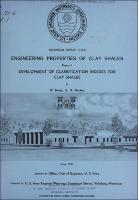Please use this identifier to cite or link to this item:
https://hdl.handle.net/11681/21558Full metadata record
| DC Field | Value | Language |
|---|---|---|
| dc.contributor.author | MacIver, Bruce N. | - |
| dc.contributor.author | Heley, William | en_US |
| dc.date.accessioned | 2017-03-14T19:37:14Z | - |
| dc.date.available | 2017-03-14T19:37:14Z | - |
| dc.date.issued | 1971-06 | - |
| dc.identifier.uri | http://hdl.handle.net/11681/21558 | - |
| dc.description.abstract | Abstract: Characteristics of clay shales are reviewed with regard to construction and maintenance problems encountered on Civil Works projects of the Corps of Engineers. Conf'usion in the description and definition of clay shale results from the variable character of the material and the subjectivity of most classification methods. It is considered inadequate to distinguish only good shales from bad shales; rather, standardized indexes are required for the quantitative classification of shales. From consideration of the several factors controlling the characteristics of clay shales, both qualitative and quantitative indexes are defined and standardized apparatus, procedures, and descriptors for each index are proposed. Particular emphasis is given to the methods for disaggregating clay shale material for index tests and the apparatus and procedures for measuring residual shear strength. It is recommended that Atterberg limits and particle-size analysis be performed on material processed (a.) from undried material, (b.) after a single cycle of air-drying and slaking, and (c.) after disaggregation by a high-speed food blender. Oven-drying and cyclic air-drying procedures are not believed to provide as useful information as these three methods. Detailed procedures are suggested for the three standardized methods for disaggregating materials, including specific equipment and operating requirements for high-speed blending. Apparatus and procedures for performing repeated direct shear and annular (or rotational) shear tests are reviewed and compared. Variations in measured residual shear strength with type of test, type of specimen, normal stress, and rate of shear displacement are discussed and illustrated with test results. The concept of both a frictional component and a geometrical component to measured residual shear strength is introduced and used to interpret the effect of reversing the direction of shear displacement in the repeated direct shear test . Details of a standardized method for determining residual shear strength are proposed, and objectives for future investigation are suggested. | en_US |
| dc.language.iso | en | en_US |
| dc.publisher | Soils and Pavements Laboratory (U.S.) | en_US |
| dc.relation | http://acwc.sdp.sirsi.net/client/search/asset/1052006 | - |
| dc.relation.ispartofseries | Technical Report;S-71-6, Report 1 | - |
| dc.subject | Clay soils--Classification | en_US |
| dc.subject | Clay minerals--Classification | en_US |
| dc.title | Engineering properties of clay shales. Report 1, Development of classification indexes for clay shales | en_US |
| dc.type | Report | en_US |
| Appears in Collections: | Technical Report | |
Files in This Item:
| File | Description | Size | Format | |
|---|---|---|---|---|
| TR S-71-6 Report 1.pdf | 43.68 MB | Adobe PDF |  View/Open |